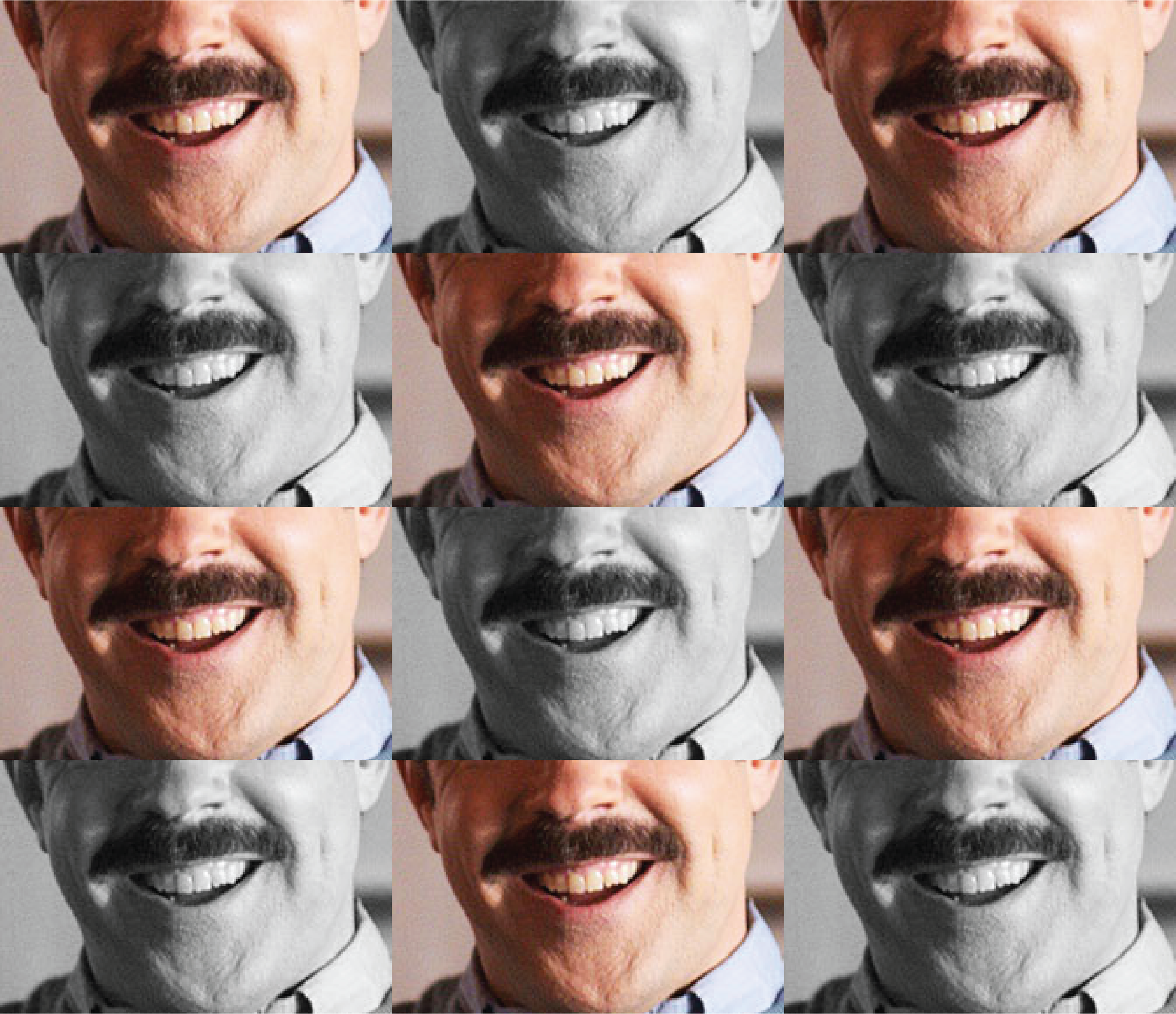
The Other Side of Niceness: Lasso, Chalk Circle, Mockingbird
First things first, know that you can count me among the people disappointed with season two of Ted Lasso. There’s an old adage that comedy is fast and there was very little fast about this season. That too many jokes were full of air would not be so troublesome if the show had maximized its best feature, namely a willingness to look past the earnestness so many of its characters strive for. The episodes that did go in an entirely different direction, like Coach Beard’s bizarro, post-FA Cup semi-final odyssey, stick out a lot in that landscape, and for all their incongruity, I found myself wanting more of that surreal, form-breaking fun. Ultimately, it seemed like the show, which still had many good moments, was suffering from some growing pains, unsure how to balance its rom-com send-ups with its darker strains of melancomedy. Finding that balance could have done a lot for the theme the show did explore very well: the other side of niceness.
A lot has already been made about the Great Nate Debate, the discourse surrounding kitman-turned-assistant-coach Nate’s transformation from timid nice guy to self-absorbed prick. I won’t spend too much time on the debate here except to say that I found many of the moves heavy-handed (the hair, really?) and sometimes confusing, to the point that, despite all the ways Nate’s darker nature was exposed over the course of the season, his sudden outburst at Ted seemed to come out of the blue. I will say, though, that Nate’s arc is one example of how the show excavates what sometimes hides behind pleasant exteriors. The lesson of Nate’s story is that “niceness” does not always equate to goodness—that even those who seem harmless can harbor selfishness to the point of narcissism. This is not to discount the many ways Nate is belittled throughout the show, but rather to say that sometimes what the “nice guys” lack that the assholes don’t is the balls to do exactly what they want.
In addition to charting a seemingly new course for Nate, the show also lets some of the characters’ pleasant facades slip. We see, for example, that Ted’s relentless positivity is not impermeable; in fact, it is covering up a very serious problem with trauma that produces, among other things, an aversion to conflict. That he begins to untangle that with Dr. Sharon is appropriate, not just in that it shows her own “professional kindness” in the form of therapy is valuable, but in that Ted is able to help her, too. We discover, in Sharon’s private moments, that for all her grasp of human nature, she is lonely and therefore vulnerable to things going wrong. Here we have two people with an aptitude for making people feel good but who have not translated that same energy into personal fulfillment. Indeed, it suggests that sometimes niceness can be a barrier as much as a doorway. While some characters were enriched by arcs that revealed their fragility, other revelations were somewhat less surprising. My bullshit detector immediately started beeping when Edwin Akufo (all-star VEEP alum Sam Richardson), the billionaire Ghanaian heir apparently intent on dismantling his father’s empire, first arrived in his helicopter and started to woo sweet-natured Sam Obisanye with extravagant purchases and promises. (Never trust a billionaire who buys ambience and uses conspicuous consumption in service of an apparently decolonial project.) That he turned out to be vindictive and crude when denied what he wants puts him in a similar category to the slippery Rupert, another billionaire with charm to spare. Interestingly, Rupert, as we discover, is actually repelled by niceness; as Rebecca’s mother points out, putting on a smile proves that he cannot get under Rebecca’s skin. For him and Akufo, good manners are about mobilizing their power in the most effective and least obvious way; once they do not have the power, niceness no longer serves them.
(Speaking of billionaires and power, it’s here that I should return to my first writing on Ted Lasso and its role in the Americanization of the Beautiful Game. If season two got one thing very right about elite soccer, it is that money calls the shots, to the point of making the game a ball pit for billionaire playboys. If we can accept that there are sometimes darker—or at the very least, cynical and commercial—interests lurking behind hyper-lucrative organizations like the Premier League, we might have to accept that Ted Lasso is being positioned for the same purpose. The fact that the Premier League is going to allow the show to use official materials and highlight packages suggests they know a good marketing opportunity when they see it.)
While Ted Lasso revealed what lies beyond niceness, other texts, such as Bertolt Brecht’s play The Caucasian Chalk Circle (stay with me here), reveal the differences articulated between niceness and kindness. As my class and I studied Brecht’s text recently, I found myself thinking back on what professor and devised theatre expert Rich Brown once explained to me and others during a workshop session: that niceness is complimenting a friend’s terrible new haircut to keep up appearances and kindness is telling them the truth because you really care. In short, kindness prioritizes a person’s needs, even to the point of superseding manners and other mores of polite society. Kindness also comes with a certain cost, as Grusha, Brecht’s heroine, discovers when she rescues a noble child named Michael from the flames of a political insurrection. As Grusha flees through the Caucasian mountains to protect herself and the baby, she is constantly reminded, in typical Brechtian fashion, of the real, material costs of keeping this child as her own. It brings her under such scrutiny that she is forced to go into hiding, first as a noblewoman to get a room for the night, then from a lascivious corporal, then in the bonds of a loveless marriage. Eventually, once Michael’s rich, selfish mother comes calling for her son in order to secure her rights afforded to his heirship, Grusha is forced to defend her right to be Michael’s mother based on the care she has shown him. The women present their case to Azdak, a roguish judge who has spent the past few scenes robbing the rich to feed the poor. As in the biblical story of Solomon, Azdak devises a test: the child will be placed in the center of a chalk circle and the women will each pull on one end to see who is strong enough to extract him and claim him as her own. Kindhearted Grusha is unable to bear the thought of harming Michael and refuses to quickly relents. Azdak sees this and awards her custody, recognizing that her love forbids her from tearing at her son.
The conclusion of The Caucasian Chalk Circle alone speaks to the notion of kindness as something deeper than respectability and social conditioning. Michael’s birthmother is perfectly respectable, but it is Grusha who has demonstrated an investment in the child’s wellbeing. Even apart from the stark contrast between these two figures, Brecht’s play constantly points to the risks Grusha incurs to do what is right. From the other workers of the palace warning her to leave the baby in the first place to the sham marriage that puts her true love at risk, the real stakes of Grusha’s decision are never out of sight. This is important to recognize in Brecht’s work, which, in the Marxist tradition he practiced, always investigates the socioeconomic position the characters occupy. It does so partly by subject matter but also through Brecht’s staging and dramaturgy, which alienate the audience (verfremdungseffekt!) from the action in such a way as to invite critical engagement resulting in ethical judgments and real-world action. Understanding Grusha’s attachment to Michael, then, is not about embracing sentiment but about identifying the material wager Grusha makes by claiming Michael as her own, even if protecting him is the right thing to do. This is partly why productions such as the 2013 one by Classic Stage Company in New York use a very obvious baby doll in all its plastic glory to represent Michael: to disrupt the theatrical illusion and remind the audience that he is a costly object. Ideally, the move does not dehumanize Michael but instead humanizes Grusha by showing her willingness to break all the rules of proper society in order to protect this precious item.
If the second season of Ted Lasso is about showing what lies behind nice faces and The Caucasian Chalk Circle examines the cost of doing good, then Aaron Sorkin’s adaptation of To Kill a Mockingbird (again, stay with me) shows the other side of people who take their goodness for granted. Based on Harper Lee’s classic 1960 novel, Sorkin’s Mockingbird, which I recently watched in the Shubert Theatre nosebleeds with my girlfriend, is written with a clear mission: to, as Sorkin says, converse with Lee’s novel and reshape it into something that responds to the moment. A lot of this is accomplished by expanding the role of Calpurnia, the Finch family’s Black domestic laborer, and playing up the degree to which Tom Robinson, the Black victim of racial injustice, is condemned by the tears of Mayella Ewell, the White woman Tom is falsely alleged to have raped. Calpurnia openly challenges Atticus Finch, the noble lawyer, when he tolerates his racist neighbors and accuses him of being sanctimonious after taking on Tom’s case. Mayella, meanwhile, is wound up to the point of hysterical rage at Tom, despite the fact that her father, as in the story, is undoubtedly her abuser. Calpurnia gives voice to Black pain by challenging Atticus’s assumptions and lamenting the death of Tom, who is shot seventeen times while trying to escape; Mayella encapsulates the privileges of whiteness, which allows her to construe her own pain into a rationale for condemning somebody else. Altogether, Sorkin’s efforts to bring To Kill a Mockingbird into today are obvious and, for the most part, successful in so far as they can bring this piece into the present. It may seem especially relevant in the ongoing racial reckonings that accelerated in 2020, but I would not characterize it as the play that best meets the moment. Still, by framing the action as a memory, as Sorkin does by casting the youths Scout, Jem, and Dill as character-narrators, the play does show how the past can bleed into the present. Though the conceit is manifested somewhat inconsistently, the effect is, at its best, moving and often thought provoking.
Where Sorkin’s play makes its most provocative changes is in the characterization of the iconic Atticus. The mere mention of the name calls to mind Gregory Peck’s almost saintly turn in the 1964 film, which crystalized him as the paragon of White liberal heroism. Although Jeff Daniels, returning to the role for the initial post-lockdown Broadway run, may not have quite the same gravitas as Peck, he does skillfully balance Atticus’s quiet decency, quick wit, and rhetorical grace. What Sorkin’s version of the role also demands is a certain shortsightedness that fuels a cantankerous temper. In Sorkin’s hands, Atticus’s commitment to basic human decency is complicated by the degree to which he lets racism slide out of deference to his neighbors. Throughout the play, Calpurnia and the children pick at Atticus’s stubborn refusal to call the racists out for who they are, taking it to the point that his belief in decency and non-confrontation is making him blind to the truth. As we come to learn, however, this version of Atticus is not afraid to get his hands dirty if necessary, as he proves when disarming the angry Mr. Ewell during a confrontation and verbally belittling him with surgical precision. It is a shockingly, if somewhat satisfyingly, violent moment for someone who has otherwise maintained nothing but restraint. Ultimately, even though Atticus defends Tom with skill and vigor, the nature of his commitment to resisting the full extent of racism’s power is left unclear. What is clear is that this Atticus’s above-it-all approach is not without his flaws, while the man himself is not without a certain edge. In my view, this demystifies Atticus Finch without harming the character’s legacy. If anything, it shows that complex people can perform heroic, if ill-fated work, even if they are not the saints we want them to be.
While it may seem odd to hold these three pieces together, I think all are instructive in the way they contrast the veneer of niceness with a deeper truth, whether that be the real selves lurking behind happy faces, the heavy costs of doing right, or the fact that sometimes being nice just covers up too many sins. As someone who has always gotten by on being nice, it is genuinely convicting to sit with work that asks something more of its characters. To do that in a way that invites audiences to reflect requires a willingness to peel away layers while ratcheting up the stakes. Ted Lasso excels at peeling layers and may, eventually, clarify the stakes. The Caucasian Chalk Circle and To Kill a Mockingbird, meanwhile, have stakes to burn. For them, the difference between niceness and kindness can mean the difference between life and death. As I see it, we have to be ready to make similar choices in real life, too.
Jadwal pertadingan malam ini
Situs berita olahraga khusus sepak bola adalah platform digital yang fokus menyajikan informasi, berita, dan analisis terkait dunia sepak bola. Sering menyajikan liputan mendalam tentang liga-liga utama dunia seperti Liga Inggris, La Liga, Serie A, Bundesliga, dan kompetisi internasional seperti Liga Champions serta Piala Dunia. Anda juga bisa menemukan opini ahli, highlight video, hingga berita terkini mengenai perkembangan dalam sepak bola.


